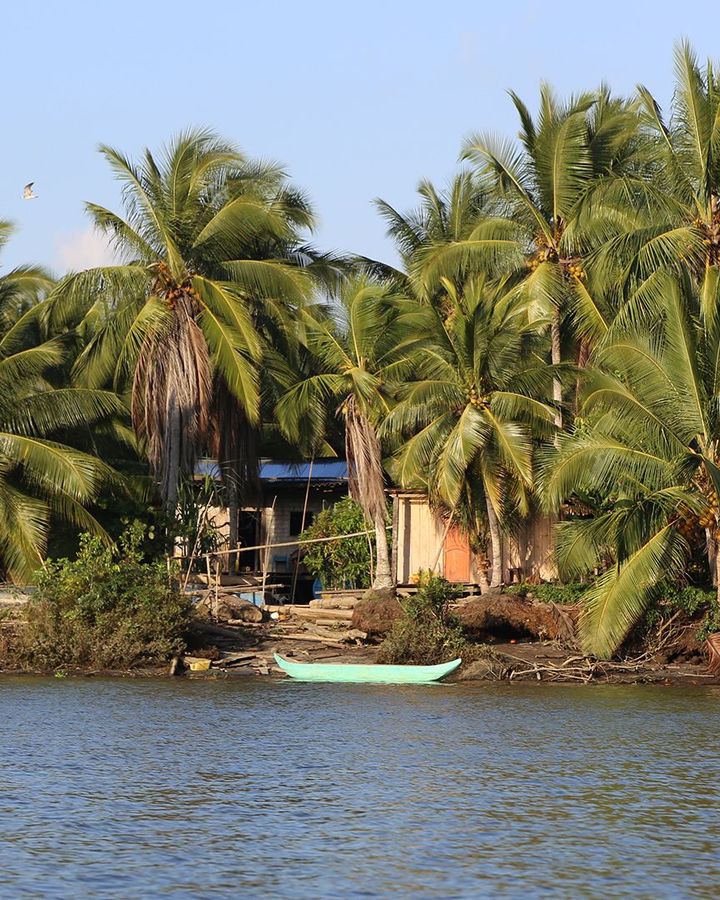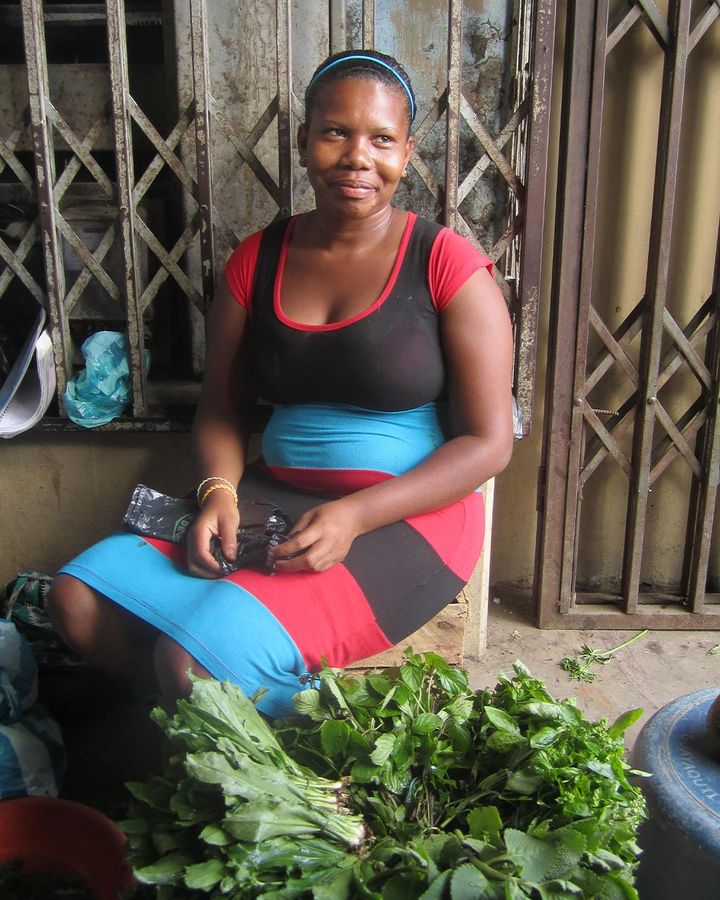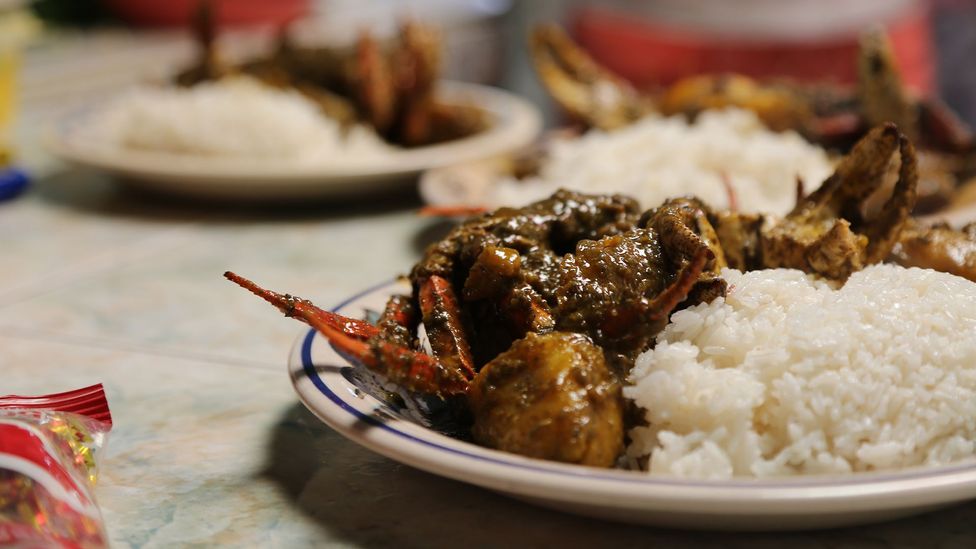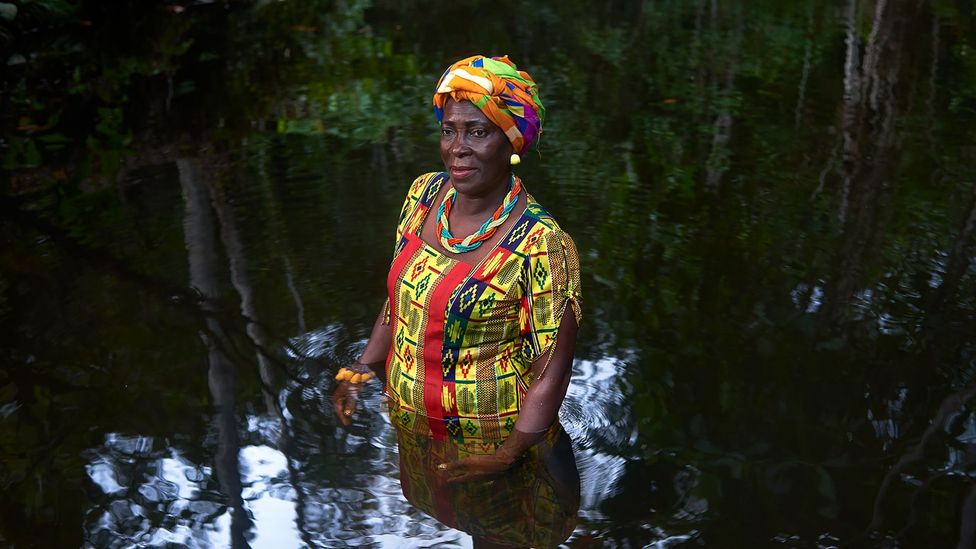As a young girl, Amada Cortez Caicedo would collect blue crabs and clams from the once dense mangrove forests along the coast of Esmeraldas, Ecuador. She and her two sisters would traverse the trees' tentacled roots that stand high above the water, to harvest them from muddy burrows.
"I liked spending time in the wetlands because you would find molluscs and crustaceans in the ground, but in the branches you would see other wildlife," says Caicedo. "So I would go and gaze at the birds and catch snails."
Caicedo's mother would sell the shellfish to market vendors, who would then sell them in big cities like Quito. The shellfish were an important source of income for the family, and they provided food sovereignty – the term used to describe indigenous people's right to eat culturally appropriate food.
A disappearing cultureEsmeraldan women like Caicedo have been gathering shells and crabs in the mangroves for generations. Although some men collect crabs as well, it's primarily young women who do so. It's a patrimonial practice and part of their cultural heritage. Today, the mangroves upon which so many Esmeraldan women depend for their way of life – and which are an intrinsic part of their collective identity – are on the brink of disappearing. If they vanish, so will the blue crabs.

The Esmeraldas coast of Ecuador, which boasts jungle, rugged beaches and coconut trees, is the home of the blue crab (Credit: Pilar Egüez Guevara)
The province of Esmeraldas in Ecuador literally means "emeralds". It's known as "the green province" for its humid tropical forests. It's located in the north-west of the country, bordering Colombia. The coasts are lined with mangroves that are still home to an abundance of plant and animal life.
Esmeraldans describe personal attachments to the mangrove ecosystem and a reciprocal relationship with it where the mangroves provide services to the community in exchange for caregiving and protection. Knowledge of how to protect it is embedded into Esmeraldans' oral tradition, and also comes from communicating with the mangroves themselves, which are viewed as a source of wisdom.
Between 25-90% of the mangroves in Ecuador have been decimated due to deforestation and intensive shrimp farming. Furthermore, the pollution from the industrial shrimp pools, such as fertilisers and antibiotics, spilled out into the environment, damaging the fragile mangrove ecosystems and the health and wellbeing of the local population.
The Esmeraldas crab, with its distinctive blue shell, orange belly, red legs and white main pincer, normally feeds on mangrove leaves and surrounding vegetation. It's a terrestrial crab, often preferring the margins of aquatic habitats like riverbanks, beaches and mangroves, but spawns in estuaries and the ocean. In mangrove habitats, it's found among the muddy tree roots, where it lives in J-shaped burrows, that can be up to 2m (6.6ft) deep.
The women of the mangroves are united and now they protect the mangroves – Amada Cortez Caicedo
The species' habitat and reproduction process has been drastically affected by human activity. Now the Esmeraldas Blue Crab species, the Cardisoma crassum, is considered an endangered species by locals, who have seen the crab's numbers decline significantly since the 1980s. They are not listed on the international database of endangered species, though; a large challenge facing the communities trying to protect the crabs is that there is little data on their numbers, and so monitoring their decline has been mostly anecdotal.
The people of Esmeraldas also face systemic racism, which they say makes it harder to conserve this culturally important species. People of African descent make up more than 40% of the population in the province, having settled there during the forced migration of Africans to America between the 1500s and 1800s.
Pilar Egüez Guevara is an anthropologist and filmmaker who focuses on the value of traditional and ancestral foods. She has researched Esmeraldan culture extensively and says that it's one of the most marginalised and forgotten regions of the country, as shown by various social indicators like education, income inequality, access to basic services and opportunities. "Part of it is because there's a lot of prejudice against people of African descent," Guevara says.
Community responseIn order to protect their food heritage and culture, Caicedo and her community are saving the blue crabs – and the mangroves the creatures inhabit.
In recent years Luna Creciente, an organization in the north of Esmeraldas, and the Union of Peasant Organisations of Esmeraldas of Ecuador (UOCE) in the south of the province, have come together to find ways to protect the Esmeraldas blue crab from extinction.
The two groups, which Caicedo has been working with, raise awareness about the importance of adhering to biannual seasonal harvesting bans on blue crab set by the Ministry of Production, Foreign Trade, Investment and Fisheries. During the month-long seasonal bans, the capture, transportation, possession, processing and marketing of the crustacean are prohibited.

A local Esmeraldan woman sits for a portrait as she sells local, indigenous herbs at market (Credit: Pilar Egüez Guevara)
The first national ban is between January and February, when the crab's pre-courtship and mating stage takes place. This stage is carried out in the outer area of the burrows, so harvesting crabs at this time would interfere with normal reproduction. The second seasonal ban occurs between August and September, during the crab's growth period, when they moult their carapace – their outer shell – for a larger one. Additionally, locals are prohibited from catching female crabs and crabs smaller than 19.05cm (7.5in) carapace length. The local crab fishers not only adhere to these rules, but they patrol the area to make sure everyone else does too.
A tracking system to monitor how these policies are helping crab populations is still in development, but locals say they're already seeing an improvement in crab numbers.
"The women of the mangroves are united and now they protect the mangroves," says Caicedo. "They only catch the crabs during normal times and during the closed seasons they don't catch them, they let them grow. They take care so that no one enters the mangroves to take the crabs at that time."
Guevara says that this kind of control system is also already embedded in Esmeraldans' oral tradition, in the form of sung poems called "arruyos". They are a musical tool which elders use to educate younger generations. "Some arruyos are about how to protect these mangrove species and the fact that they shouldn't catch them when premature," Guevara says. Alongside the arruyos, the government bans focus on the non-indigenous population, as well as Esmeraldans who may have lost touch with these ancestral traditions and oral storytelling.
In the north of the province, where the mangrove ecosystem is more intact than in the south, mangrove restoration efforts are underway. "We're carrying out an environmental project with the support of the World Food Programme," says Caicedo. The mangroves in the south of the province are damaged beyond repair, according to local experts but those in the north are still intact enough to be restored.
What we're betting on as farmers, fishermen and gatherers is ecological tourism linked to our traditional cuisines – Nancy Bedón
"Technicians are there and work with the communities to plant mangroves in the spaces devastated by the shrimp farms," Caicedo adds. "The project is beautiful." This climate change adaptation project involves 66 communities in the Mira-Mataje and Guáitara-Carchi watersheds along the Ecuador-Colombia border. The project aims to reforest 988 acres (400 hectares) of land and conserve 37,000 acres (15,000 hectares) of mangroves. Restoring the blue crab's habitat gives the species a better chance to bounce back.
In addition to conserving the blue crab species and the mangroves it inhabits, Esmeraldans are also protecting the blue crab through gastronomy, highlighting the crab as a symbol of their unique food culture.
In 2018, Luna Creciente and UOCE petitioned to have the Esmeraldas blue crab recognized by Slow Food International, a global organisation that seeks to prevent the disappearance of local food cultures and traditions.
One of the ways Slow Food does this is by raising awareness through the development of an "Ark of Taste", a living catalogue of endangered heritage foods that are sustainably produced, unique in taste and part of a distinct region in the world. The Ark lists foods such as Tanzanian wild honey, which is harvested with the help of honeyguide birds leading foragers to beehives where the honey is found.
Applying the term "endangered" to foods is a novel concept, the word usually applied to plant and animal species, but it helps to draw attention to the thousands of foods around the world that are at risk of disappearing forever.
Another tool is the development of Slow Food Presidia, projects to help sustain quality food production processes protecting traditional foods, while also respecting soil, water, animal welfare and biodiversity.
In the case of the Esmeraldas blue crab, the presidium has worked on strengthening the value chain for the blue crab – the chain of events to get from harvesting to market sale. This means the entire process of harvesting the crab is protected from beginning to end, and the community is more invested in ensuring that they are sustainably harvested.
Once the crabs have reached the age of maturity, they're gathered and brought to feeding pens. With the help of the presidium, six pens were built by the participating Esmeraldan cantons of Muisne, Atacames and San Lorenzo, to contain harvested crabs and allow them to grow bigger. The feedlots were constructed by first digging 30cm (12in) into the soil, then adding stones and cement to form the base. The circular walls were then created by stacking three rows of bricks, which were then covered in tiles. The pens are about 1m (3.3ft) high and 2.5m (8.3ft) in diameter.
The foods that we are trying to protect are in low demand because people have forgotten their traditions – Pilar Egüez Guevara
A key part of this presidium is the "mink'a" (voluntary collective), in which community members take ownership of the crabs by feeding them foods like coconut, banana, cassava and sugarcane for about three weeks to improve the crab's taste and quality. The crabs are then harvested and the meat is sent to nearby processing centres, also run by locals.
Processing centres in the north and south of Esmeraldas have been fitted with vacuum-packing devices for the meat and freezers to conserve the meat before getting it to market. Generating added value in this way allows Esmeraldan women to sell the crab at a higher price. Processed products also offer an income even when the crabbing season is closed.
These projects are also upskilling young Esmeraldan women in jobs such as fishing, cooking, meat removal, packaging, freezing and legal procedures. As well as opening new commercial opportunities, they strengthen ties to the tourism industry and encourage direct contact with urban customers.
"We need to continue involving and training our youth – the new generation of farmers, fishermen, gatherers. So that they can dream and see themselves as farmers, so that they see an opportunity in the territory," says Nancy Bédon, president of the UOCE.
Finally, Esmeraldan women are continuing their long-held roles as knowledge keepers through their oral tradition, by safeguarding recipes and organising workshops where community members teach each other how to prepare local dishes.
In the long term, Bedón says that the crab collectors and Esmeraldans are looking for alternatives for economic survival. They're hoping to develop sustainable farming projects in the various sensitive ecosystems in their territory, which include mangroves, beaches and forests.
Recovering species like the blue crab and their habitats will allow them to promote their healthy ecosystems to tourists. "What we're betting on as farmers, fishermen and gatherers is ecological tourism linked to our traditional cuisines."
This would create new economic avenues for Esmeraldan women. For example, in addition to selling blue crab meat, they can offer tourists meals with flavours they won't find in any other part of the country.

"Encocado", traditional blue crab coconut stew, is made with crabs, coconuts and traditional coastal herbs such as chillangua and chirarán (Credit: Pilar Egüez Guevara)
One of the emblematic dishes from Esmeraldas is "encocado", blue crab coconut stew. "Crab encocado is a powerful symbol because crab and coconut are foods that make the region's cuisine distinctive," Guevara says. In addition to blue crab and coconut, the dish contains annatto seed paste and coastal herbs: chillangua (long coriander), chirarán (basil) and big leaf oregano. Preserving recipes and increasing demand for the blue crab will further incentivise the community to sustainably harvest the crustacean and protect its mangrove habitat.
Guevara says that a crucial part of protecting a seed or food item that's under threat of disappearing from the culture, in addition to growing it in an environmentally sustainable way, is preserving the food traditions that go along with it. "The foods that we are trying to protect are in low demand because people have forgotten their traditions. These foods are no longer found in homes, supermarkets or menus. These recipes are not being made anymore." she says.
ChallengesDespite Esmeraldans' best efforts to protect the blue crab, earthquakes, major floods and a vulnerability to El Niño weather patterns have hindered their progress.
Ecuador's mangroves are a natural buffer against storms and extreme weather like El Niño. They defend against rising sea levels, stabilise the coastline, and reduce erosion. So when most of the mangroves were destroyed in the 1970s and 1980s to build shrimp aquaculture farms, the local communities' natural defense was destroyed as well, making them even more vulnerable to extreme weather. The floods last year caused the crab feeding pens to overflow with mud and water, killing all the crabs Esmeraldans had collected.
Caicedo is now 65, a retired schoolteacher, poet and the leader of the Black Women's Movement of the North of Esmeraldas (Momune). She is a guardian of Afro-Ecuadorian heritage, including the value of the mangroves, blue crabs and Esmeraldan cuisine. Although she no longer collects shellfish in the mangroves, her writing still pays homage to her early days in the mangrove forests and waterways carved into the Esmeraldan coastal landscape.
Many of Caicedo's poems reflect on the Esmeraldans' relationship to the mangroves and the foods that come from them, which are a part of their identity and perceptual world.
Through the act of harvesting and cooking blue crabs, Esmeraldans relate to one another, to the land, and experience it in all its sensory richness through sight, smell and taste. Caicedo's poems ensure that her communities' traditions and values are not lost.
"My poetry tells the story of our strength as women, with the potential to build a new story, with our own lyrics," Caicedo adds.
--
Sign up to Future Earth
Sign up to the Future Earth newsletter to get essential climate news and hopeful developments in your inbox every Tuesday from Carl Nasman. This email is currently available to non-UK readers. In the UK? Sign up for newsletters here.
If you liked this story, sign up for The Essential List newsletter – a handpicked selection of features, videos and can't-miss news delivered to your inbox every Friday.
Join one million Future fans by liking us on Facebook, or follow us on Twitter or Instagram.
